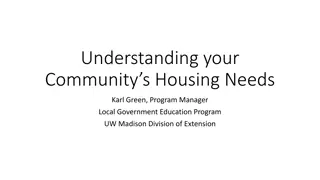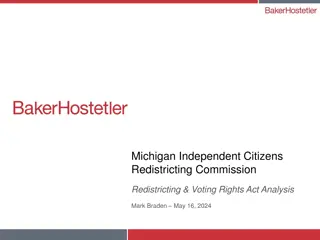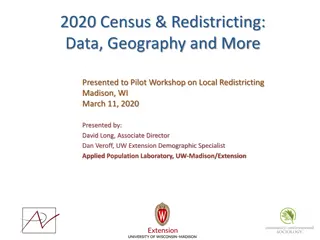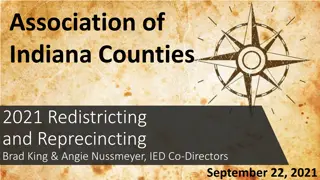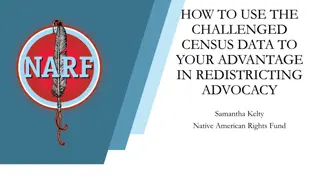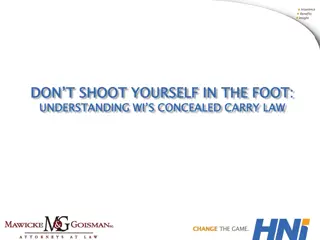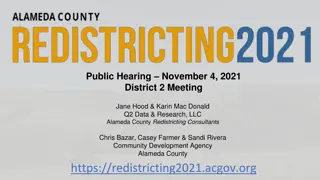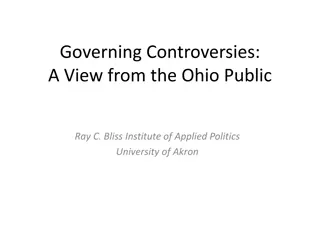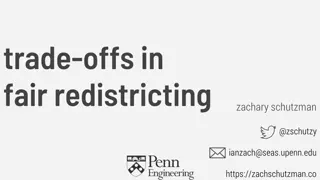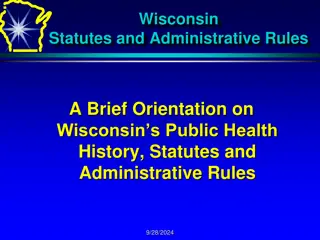Understanding Local Redistricting in Wisconsin
Explore the principles and process of local redistricting in Wisconsin, including basic redistricting law, the role of the Legislative Reference Bureau, federal and state constitutional requirements, and terminology related to redrawing electoral district boundaries. Images help visualize key concepts.
Download Presentation

Please find below an Image/Link to download the presentation.
The content on the website is provided AS IS for your information and personal use only. It may not be sold, licensed, or shared on other websites without obtaining consent from the author. Download presentation by click this link. If you encounter any issues during the download, it is possible that the publisher has removed the file from their server.
E N D
Presentation Transcript
Local Redistricting in Wisconsin Law Principles Process Staci Duros Michael Gallagher Joe Kreye
Overview Information on the Legislative Reference Bureau (LRB) Basic redistricting law and principles Local redistricting procedure and timeline
Since 1901 Nonpartisan and confidential legislative drafting services to legislators and others in state government with drafting privileges Nonpartisan and confidential research services to legislators, state and local government officials and agencies, and the public Legislative Reference Bureau
Terminology Redistricting is the process by which electoral district boundaries are redrawn periodically to adjust for shifts in population and to ensure proper representation for all potential voters in a given geographic area. Reapportionment refers to (re)dividing the number of seats in the U.S. House of Representatives based on each state s portion of the national population.
Federal Constitutional Requirements The actual Enumeration shall be made within three Years after the first Meeting of the Congress of the United States, and within every subsequent Term of ten Years, in such Manner as they shall by Law direct. U.S. Const. art. 1, 2, cl. 3.
Federal Constitutional Requirements Representatives shall be apportioned among the several States, according to their respective numbers, counting the whole number of persons in each State . -U.S. Const. amend. XIV, 2.
Federal Misc. Under Title 13 of the U.S. Code, Congress delegated the responsibility and management of the census to the U.S. Department of Commerce and its U.S. Census Bureau.
State Constitutional Requirements At its first session after each enumeration made by the authority of the United States, the legislature shall apportion and district anew the members of the senate and assembly, according to the number of inhabitants. -Wis. Const. art. IV, 3.
Federal Redistricting Requirements Equal population Minority protection
Central principle for redistricting One person, one vote Equal Population Statistical measurements: Ideal population Absolute deviation Relative deviation Overall range
Ideal Population Target or Ideal Population = Total population of the unit being divided Number of districts being created
Example Ideal Population SENATE ASSEMBLY 5,843,443 33 = 59,025 5,843,443 99 = 177,074
Absolute Deviation (AD) AD = Total population Ideal population AD is used to determine the extent to which a district is larger or smaller than the ideal district size.
Relative Deviation (RD) RD = Absolute deviation ideal population NOTE - both AD and RD are used to assess equality of population at the district level.
Examples If the ideal population per district is 100,000 and the actual population of a particular district is 99,000: AD = Total population Ideal population; so the district s AD is 1,000. RD = Absolute deviation ideal population, so the district s RD is -1 percent.
Overall Range The difference in population between the smallest and the largest districts Used as a measurement to evaluate a redistricting plan as a whole, whether at the state or local level.
Example If the largest district s population is 101,000 and the smallest district s population is 98,000, the overall range is: One starts with the ideal population, which is 100,000; we know that the largest district is +1,000 and the smallest district is -2,000, so the overall range, ignoring + and - would be 3,000 people or 3 percent.
Overall Range An overall range that is less than 10 percent is generally regarded as complying with one person, one vote.
Overall Range When drawing state and local legislative districts, jurisdictions are permitted to deviate somewhat from perfect population equality to accommodate traditional districting objectives, among them: preserving the integrity of political subdivisions, maintaining communities of interest, and creating geographic compactness. When the maximum population deviation between the largest and smallest district is less than 10 percent, a state or local legislative map presumptively complies with the one-person, one-vote rule. U.S. Supreme Court
Constitutional Standards for Equal Population Congressional districts must be as nearly equal in population as practicable [Wesberry v. Sanders, 376 U.S. 1 (1964)] Strict enforcement - no level of population inequality is deemed too small for judicial challenge [Karcher v. Daggett, 462 U.S. 725 (1983)]
Constitutional Standards for Equal Population Legislative districts must be drawn with substantial equality of the population, [Reynolds v. Sims, 377 U.S. 533 (1964)]. Substantial equality means an overall range of 10 percent from the ideal population, [Brown v. Thompson, 462 U.S. 835 (1983)].
Constitutional Standards for Equal Population Wisconsin has historically applied a much higher population deviation standard for its districts with an overall range of less than 2 percent [AFL-CIO v. Elections Bd., 543 F. Supp. 630 (E.D. Wis. 1982)]. 1982 - 1.74 % 1992 - 0.91 % 2002 - 1.59 % 2011 - 0.76 %
Protection of Minorities 1965 Voting Rights Act (VRA) enacted by Congress to remedy the inequality of opportunity given to racial and ethnic minorities to participate in elections. Section 2
Section 2 of the 1965 VRA Prohibits any state or political subdivision from imposing a voting qualification or prerequisite to voting, or standard, practice or procedure to deny or abridge the right to vote on account of race or color.
Section 2 of the 1965 VRA In 1975, the ban on voting qualifications or prerequisites made permanent and coverage of the act was broadened to include members of language minority groups. In 1982, Section 2 applied to any plan that results in discrimination against a member of a racial or ethnic minority group, regardless of the intent of the plan s drafters.
Vote Dilution A redistricting map may be constitutionally challenged if it splits up a race or language minority group and combines its members with a majority group, effectively limiting the ability of that minority group to elect a candidate of its choice. This is known as vote dilution.
Protection of Minorities in Practice A redistricting plan, in which the voting strength of a minority group is diluted, is most often constitutionally challenged because the plan violates either Section 2 of the Voting Rights Act of 1965 or the equal protection clause of the Fourteenth Amendment (or sometimes both).
Many states impose additional redistricting requirements, referred to generally as traditional districting principles. Compactness Contiguity Preserving communities of interest Preserving the unity of political subdivisions Competitiveness Other Redistricting Principles
Traditional Redistricting Principles Shaw v. Reno (Shaw I), 509 U.S. 630 (1993) used the term traditional districting principles and the Court identified them as compactness, contiguity, and respect for political subdivisions. Plans permitted to deviate somewhat from perfect population equality to accommodate traditional districting objectives, among them: preserving the integrity of political subdivisions, maintaining communities of interest, and creating geographic compactness. [Evenwel v. Abbott, 578 U.S _____ (2016).]
Compactness The general principle of minimizing the distance between all parts of a district. Types: area, dispersion, and perimeter.
Contiguity The general principle that all areas within a district should be physically adjacent or a district that is within one continuous boundary and whose parts all touch one another at more than a point. Some districts stretch the limits of this requirement by connecting different landmasses through water or having two districts intersect at a single point that takes up no area.
Communities of Interest The general principle that it is desirable to group like- minded or similar people so that they may elect a representative that reflects a common interest relevant to legislative representation. A community of interest must be viewed separately from those racial, ethnic, or linguistic groups who are protected by federal law.
Unity of Political Subdivisions The principle to avoid cross county, city, or town, boundaries when drawing districts.
Competitiveness The general principle that political parties or incumbents sometimes draw district lines for their benefit at the expense of proportionality and fair representation.
WIs Redistricting Requirements Article IV of the Wisconsin Constitution governs the basic requirements for legislative redistricting. Section 4 - requires assembly districts to be bounded by county, precinct, town, or ward lines, to consist of contiguous territory, and be in as compact form as practicable. Section 5 - requires senate districts to be of convenient contiguous territory at the same time and in the same manner as members of the assembly are to be chosen.
Local Redistricting Law and Process Overview Wards Building Blocks for Election Districts Three Phases of Local Redistricting Reporting Requirements Local Redistricting Timeline
Wards: The Building Blocks of Election Districts Governed by section 5.15 of the Wisconsin Statutes Building blocks from which all election districts are created Referred to by the Census Bureau as voting districts Not election districts not subject to equal population requirements Intended to be as permanent as possible Required for municipalities with a population of at least 1,000 Under 1,000, may, but not required to divide into wards
Rules for Creating Wards (Wis. Stat. 5.15) Wards must: Be comprised of whole census blocks, subject to exceptions. To suit the convenience of the voters, be kept compact and observe the community of interest of existing neighborhoods and other settlements. Be comprised of contiguous territory. Comply with the population ranges specified by law, and, when created, contain a population at a convenient point within the applicable range. Lie entirely within one municipality and one county. Be designated by consecutive, unique whole numbers beginning with the number one.
Ward Population Ranges (Wis. Stat. 5.15 (2)(b)) Population of Municipality Ward Population Range Cities over 150,000 1,000 to 4,000 Cities 39,000 to 149,999 800 to 3,200 Cities, villages, or towns 10,000 to 38,999 600 to 2,100 1,000 to 9,999 300 to 1,000 Fewer than 1,000 No division required
Phase 1: Tentative County Supervisory Plans Within 60 days after the official publication of P.L. 94- 171 data but no later than July 1 following the year of each decennial census [i.e. July 1, 2021], the county board is required to adopt a preliminary county supervisory district plan. (Wis. Stat. 59.10 (3) (b) 1.)
Adopting a Tentative County Supervisory Plan (Wis. Stat. 59.10 (3) (b) 1.) In proposing a tentative county supervisory district plan, the county board must: Solicit suggestions from municipalities. Hold a public hearing, after which the plan may be amended. Provide a copy of the plan once adopted to each municipality in the county, and written notice to each affected municipality, if the division of a municipality is sought.
Adopting a Tentative County Supervisory Plan(Wis. Stat. 59.10 (3) (b) 1.) Each tentative plan must satisfy all of the following: The number of districts must equal the number of supervisors. Districts must be substantially equal in population. Districts must generally consist of whole wards or municipalities. Territory within each district must be contiguous, except for island territory.
Phase 2: Municipalities Adjust Ward Boundaries After receiving the tentative supervisory district plan, municipalities have 60 days to adjust ward boundaries. (Wis. Stat. 5.15 (1) (b)) Every municipality shall make a good faith effort to accommodate the tentative plan submitted by the county or counties in which it is located under s. 59.10 (2) (a) or (3) (b) 1., and shall divide itself into wards in such a manner that will permit the creation of county supervisory districts in accordance with the population requirements for the plan specified in s. 59.10 (2) (a) or (3) (b) 1. (Wis. Stat. 5.15 (2) (d)) Wards must reflect the municipal boundaries in place on Census Day.
Adjusting Ward Boundaries (Wis. Stat. 5.15) Wards boundaries may require adjustment to: Reflect changes in population. Reflect changes in minority population. Reflect changes in municipal boundaries. Facilitate the establishment of county supervisory districts of equal population. Facilitate the creation of aldermanic districts of equal population. Accommodate a legislative redistricting plan. (2011 Wisconsin Act 39)
Phase 3: Counties Adopt Final Supervisory Districts; Cities Set Aldermanic Districts Within 60 days after every municipality in a county adjusts its wards, the county board is required to conduct a second public hearing after which it adopts a final supervisory district plan and numbers each supervisory district. (Wis. Stat. 59.10 (3) (b) 2.) Within 60 days after its wards have been readjusted, the common council of each city not electing its common council at large is required to redistrict the boundaries of its aldermanic districts. An ordinance must be adopted by a majority vote of all the members of the council. (Wis. Stat. 62.08 (1))
2021 Local Redistricting Timeline Requirement Completion By March or April 2021 P.L. 94-171 file received and published Counties adopt tentative supervisory plans June 2021 Municipalities adjust ward boundaries August 2021 Counties establish supervisory districts October 2021 Cities establish aldermanic districts October 2021






